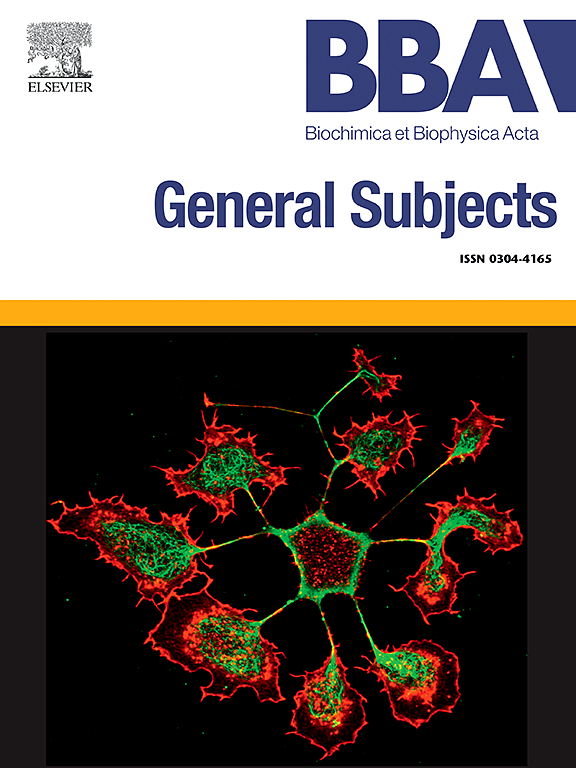基于生物碱的醛糖还原酶抑制机制:计算视角和实验验证
IF 2.2
3区 生物学
Q3 BIOCHEMISTRY & MOLECULAR BIOLOGY
Biochimica et biophysica acta. General subjects
Pub Date : 2025-07-09
DOI:10.1016/j.bbagen.2025.130841
引用次数: 0
摘要
过度的醛糖还原酶活性导致多元醇通路损伤,而多元醇通路损伤是糖尿病性白内障、神经病变和肾病的基础,但很少有安全、有效的AR抑制剂进入临床。在这里,我们综合了虚拟筛选、原子模拟和酶学来评估六种天然生物碱——花青素、芦果卡松、青氨酸、sparteine、小檗碱和粉防己碱——作为潜在的AR拮抗剂。2500个化合物的AutoDock Vina筛选筛选出这些支架具有高预测亲和力(≤- 7.0 kcal mol - 1),化学型多样性和良好的硅显影性。对接定位所有配体在催化裂孔内;200-ns MD轨迹和自由能景观显示,rutaecarpine和双苄基异喹啉粉防己碱和小檗碱同时夹住阴离子结合和特异性口袋,将构象空间塌陷成一个单一的深盆地。MM/PBSA分析显示粉防己碱最高(ΔGtotal =−35.8±2.5 kcal mol−1),其次是胡卡松碱(−23.0±1.3 kcal mol−1)和小檗胺(−19.4±2.7 kcal mol−1);残基分解突出显示Phe122、Trp219和Leu300是反复出现的热点。在体外,出现了相同的层次结构:粉防己碱抑制重组人AR的IC₅₀值为1.56±0.23 μM,优于槲皮素(2.37±0.27 μM),而芦卡松和小檗胺的IC₅₀值分别为4.84±0.81和7.35±0.78 μM。Lineweaver-Burk和Michaelis-Menten图显示非竞争性抑制,与md推断的口袋夹紧机制一致。ADMET分析确定rutaecarpine是最平衡的铅(Lipinski-compliant,中度hERG/CYP风险),而粉防己碱的hERG敏感性和低溶解度需要支架改进。本研究验证了双苄基异喹啉和吲哚-喹唑啉酮框架是优越的AR抑制化学型,并展示了端到端计算实验管道,可快速将民族药理学分子转化为机制特征的先导物,用于管理糖尿病并发症。本文章由计算机程序翻译,如有差异,请以英文原文为准。
Mechanism of alkaloid-based inhibition of aldose reductase: Computational perspectives and experimental validations
Excessive aldose reductase activity drives the polyol-pathway damage that underlies diabetic cataract, neuropathy and nephropathy, yet few safe, potent AR inhibitors have reached the clinic. Here we integrated virtual screening, atomistic simulation and enzymology to evaluate six natural alkaloids—calycanthine, rutaecarpine, glaucine, sparteine, berbamine and tetrandrine—as prospective AR antagonists. A 2500-compound AutoDock Vina screen singled out these scaffolds for high predicted affinity (≤ − 7.0 kcal mol−1), chemotype diversity and favorable in silico developability. Docking located all ligands within the catalytic cleft; 200-ns MD trajectories plus free-energy landscapes revealed that rutaecarpine and the bis-benzylisoquinolines tetrandrine and berbamine clamp the anion-binding and specificity pockets simultaneously, collapsing conformational space into a single deep basin. MM/PBSA analysis ranked tetrandrine highest (ΔGtotal = −35.8 ± 2.5 kcal mol−1) followed by rutaecarpine (−23.0 ± 1.3 kcal mol−1) and berbamine (−19.4 ± 2.7 kcal mol−1); per-residue decomposition highlighted Phe122, Trp219 and Leu300 as recurring hot-spots. In vitro, the same hierarchy emerged: tetrandrine inhibited recombinant human AR with an IC₅₀ of 1.56 ± 0.23 μM, outperforming quercetin (2.37 ± 0.27 μM), while rutaecarpine and berbamine yielded IC₅₀ values of 4.84 ± 0.81 and 7.35 ± 0.78 μM, respectively. Lineweaver–Burk and Michaelis–Menten plots demonstrated non-competitive inhibition, aligning with the MD-inferred pocket-clamping mechanism. ADMET profiling identified rutaecarpine as the most balanced lead (Lipinski-compliant, moderate hERG/CYP risk), whereas tetrandrine's hERG liability and low solubility call for scaffold refinement. This study validates bis-benzylisoquinoline and indolo-quinazolinone frameworks as privileged AR inhibitory chemotypes and showcases an end-to-end computational–experimental pipeline that rapidly converts ethnopharmacological molecules into mechanistically characterized leads for managing diabetic complications.
求助全文
通过发布文献求助,成功后即可免费获取论文全文。
去求助
来源期刊

Biochimica et biophysica acta. General subjects
生物-生化与分子生物学
CiteScore
6.40
自引率
0.00%
发文量
139
审稿时长
30 days
期刊介绍:
BBA General Subjects accepts for submission either original, hypothesis-driven studies or reviews covering subjects in biochemistry and biophysics that are considered to have general interest for a wide audience. Manuscripts with interdisciplinary approaches are especially encouraged.
 求助内容:
求助内容: 应助结果提醒方式:
应助结果提醒方式:


